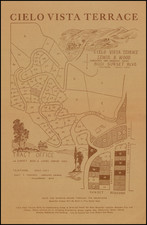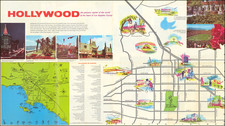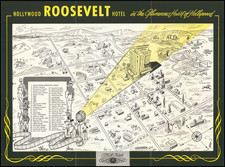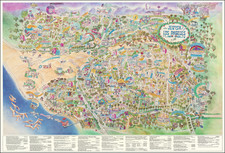Early Map of Hawthorne -- A Southern California Sundown Town
Finely executed map of the city of Hawthorne, compiled by W.R. Barclay, Hawthorne City Engineer in 1932.
The map illlustrates a well organized town plan, dissected by Hawthorne Avenue (now Boulevard) and efficiently served by rail connections from the north and south and served by an east-west artery that intersects at Broadway Circle in the center of town. At the time of printing, the vast majority of residents lived in the northeast quadrant, with the rest of the town thinly populated and largely undeveloped.
Issued just 10 years after the city was incorporated in 1922, the map is apparently an official map of the city, as it includes notes from the mayor and city council "attesting" to the map. While it seems likely that there are earlier printed maps of Hawthorne, this is the earliest map we could locate, pre-dating by 8 years the earliest map of Hawthorne listed in OCLC.
At the time of publication, the population of Hawthorne was about 7,000. It was also one of a number of so-called Sundown Towns which did not allow African-Americans to live in the town or remain in town after sundown.
Hawthorne, California -- Sundown Town
Hawthorne was founded in 1906 as the "Hawthorne Improvement Company" by B.L. Harding and H.D. Lombard. Harding's daughter shared her birthday, the 4th of July, with New England author Nathaniel Hawthorne, and a decision was made to name the city after him. It was made up of 80 acres of barley fields and previously planted eucalyptus trees on land halfway between Los Angeles and Redondo Beach.
Hawthorne was billed as “the most beautiful suburban town,” ideal for hardworking families looking for a simple, child-friendly way of life. Chicken and vegetable farmers were recruited, and lots were offered for reasonable rates. By 1908, the nascent town included a grocery store and an all-purpose community building housing a church and school house. Small wood frame homes sprang up on plots of land improved with chicken coops and gardens.
By 1914, Hawthorne was a thriving little village. Most of the townspeople were farmers or employees of the thriving Hawthorne Furniture Company. But, in 1914, Hawthorne’s growth was abruptly stunted when the company’s factory burned to the ground and other industries left town.
Developers employed many curious tactics to promote the town's growth In 1925, the Hopkins-McNeil Investment Company, in the style of popular evangelical preachers like Aimee Semple McPherson, threw weekly Hawthorne “revivals.” These events, featuring singing and speeches, drew upward of 1,000 people. Eager to spread the gospel of Hawthorne to a wider swath of potential homeowners, in 1926, the Hawthorne Chamber of Commerce sent out an advertising car on an eight-month trip to the Midwest and East Coast. The side of the car read: “Hawthorne Cal: A thriving city of homes twelve miles from Los Angeles. Sunshine all year.
Hawthorne was once a "whites only" settlement, commonly called a sundown town. During the 1930s, signs warned African-Americans to be out of Hawthorne by sundown.
Rarity
The map is very rare. OCLC locates two later editions of the map (1939 edition at UCLA and 1948 edition at University of Milwaukee at Wisconsin).









![[ California Petroleum ] A Description of the Recently Discovered Petroleum Region in California. With a Report on the Same [with:] Map Representing Locality of The Ojai Ranch in Santa Barbara County, California, belonging to the California Petroleum Company 1865](https://storage.googleapis.com/raremaps/img/small/103844.jpg)
![(Los Angeles Architecture) [Photograph of a 1920s Spanish Colonial Revival home, likely in the Hollywood Hills area; with glass plate negative]](https://storage.googleapis.com/raremaps/img/small/96755.jpg)



